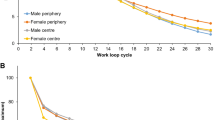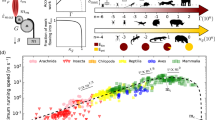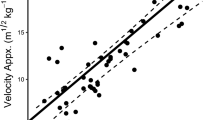Abstract
Muscle work and power are important determinants of movement performance in animals. How these muscle properties scale determines, in part, the scaling of performance during movements, such as jump height or distance. Muscle-mass-specific work is predicted to remain constant across a range of scales, assuming geometric similarity, while muscle-mass-specific power is expected to decrease with increasing scale. We tested these predictions by examining muscle morphology and contractile properties of plantaris muscles from frogs ranging in mass from 1.28 to 20.60 g. Scaling of muscle work and power was examined using both linear regression on log10-transformed data (LR) and non-linear regressions on untransformed data (NLR). Results depended on the method of regression not because of large changes in scaling slopes, but because of changing levels of statistical significance using corrections for multiple tests, demonstrating the importance of careful consideration of statistical methods when analyzing patterns of scaling. In LR, muscle-mass-specific work decreased with increasing scale, but an accompanying positive allometry of muscle mass predicts constant movement performance at all scales. These relationships were non-significant in NLR, though scaling with geometric similarity also predicts constant jump performance across scales, because of proportional increases in available muscle energy and body mass. Both intrinsic shortening velocity and muscle-mass-specific power were positively allometric in both types of analysis. Nonetheless, scale accounts for little variation in contractile properties overall over the range examined, indicating that other sources of intraspecific variation may be more important in determining muscle performance and its effects on movement.



Similar content being viewed by others
References
Alexander RM, Bennet-Clark HC (1977) Storage of elastic strain energy in muscle and other tissues. Nature 265:114–117
Altringham JD, Johnston IA (1990) Scaling effects on muscle function: power output of isolated fish muscle fibres performing oscillatory work. J Exp Biol 151:453–467
Altringham JD, Morris R, James RS, Smith CI (1996) Scaling effects on muscle function in fast and slow muslces of Xenopus laevis. Exp Biol Online 1 (6)
Askew GN, Marsh RL (2002) Muscle designed for maximum short-term power output: quail flight muscle. J Exp Biol 205:2153–2160
Astley HC, Roberts TJ (2012) Evidence for a vertebrate catapult: elastic energy storage in the plantaris tendon during frog jumping. Biol Lett 8(3):386–389. https://doi.org/10.1098/rsbl.2011.0982
Autumn K, Hsieh ST, Dudek DM, Chen J, Chitphan C, Full RJ (2006) Dynamics of geckos running vertically. J Exp Biol 209(2):260–272. https://doi.org/10.1242/jeb.01980
Benjamini Y, Hochberg Y (1995) Controlling the false discovery rate: a practical and powerful approach to multiple testing. J Roy Stat Soc: Ser B (Methodol) 57(1):289–300
Bennet-Clark HC (1977) Scale effects in animal jumping. In: Pedley TJ (ed) Scale effects in animal locomotion. Academic Press Ltd., London
Bennet-Clark HC, Lucey ECA (1967) The jump of the flea: a study of the energetics and a model of the mechanism. J Exp Biol 47:59–76
Bennett AF, Garland T Jr, Else PL (1989) Individual correlation of morphology, muscle mechanics, and locomotion in a salamander. Am J Physiol 256(6):R1200-R1208
Biewener AA (2003) Animal locomotion. Oxford Animal Biology Series. Oxford University Press Inc., New York, NY
Bonner JT (2006) Why size matters: from bacteria to Blue Whales. Princeton University Press, Princeton
Borelli GA (1680) De Motu Animalium (English Translation by P. Maquet). Springer, Berlin
Curtin NA, Woledge RC (1988) Power output and force–velocity relationship of live fibres from white myotomal muscle of the dogfish, Scyliorhinus canicula. J Exp Biol 140:187–197
Deban SM, O’Reilly JC (2005) The ontogeny of feeding kinematics in a giant salamander Cryptobranchus alleganiensis: does current function or phylogenetic relatedness predict the scaling patterns of movement? Zoology (Jena) 108(2):155–167. https://doi.org/10.1016/j.zool.2005.03.006
Deban SM, O’Reilly JC, Dicke U, van Leeuwen JL (2007) Extremely high-power tongue projection in plethodontid salamanders. J Exp Biol 210(Pt 4):655–667. https://doi.org/10.1242/jeb.02664
Emerson SB (1978) Allometry and jumping in frogs: helping the twain to meet. Evolution 32(3):551–564
Emerson SB (1985) Jumping and leaping. In: Hildebrand M, Bramble DM, Liem KF, Wake DB (eds) Functional vertebrate morphology. Harvard University Press, Cambridge, MA
Fischmeister R, Hartzell HC (1987) Cyclic guanosine 3′, 5′-monophosphate regulates the calcium current in single cells from frog ventricle. J Physiol 387:453–472
Glazier DS (2013) Log-transformation is useful for examining proportional relationships in allometric scaling. J Theor Biol 334:200–203. https://doi.org/10.1016/j.jtbi.2013.06.017
Hill AV (1950) The dimensions of animals and their muscular dynamics. Sci Prog 38:209–230
Hu DL, Chan B, Bush JWM (2003) The hydrodynamics of water strider locomotion. Nature 424:663–666
James RS, Johnston IA (1998) Scaling of muscle performance during escape responses in the fish Myoxocephalus scorpius L. J Exp Biol 201:913–923
James RS, Cole NJ, Davies MLF, Johnston IA (1998) Scaling of intrinsic contractile properties and myofibrillar protein composition of fast muscle in the fish Myoxocephhalus scorpius L. J Exp Biol 201:901–912
James RS, Vanhooydonck B, Tallis JA, Herrel A (2015) Larger lacertid lizard species produce higher than expected iliotibialis muscle power output: the evolution of muscle contractile mechanics with body size. J Exp Biol 218(Pt 22):3589–3595. https://doi.org/10.1242/jeb.124974
Johnson TP, Swoap SJ, Bennett AF, Josephson RK (1993) Body size, muscle power output and limitations on burst locomotor performance in the lizard Dipsosaurus dorsalis. J Exp Biol 174:199–213
Lemaitre JF, Vanpe C, Plard F, Pelabon C, Gaillard JM (2015) Response to Packard: make sure we do not throw out the biological baby with the statistical bath water when performing allometric analyses. Biol Lett 11(6):20150144. https://doi.org/10.1098/rsbl.2015.0144
Lutz GJ, Rome LC (1994) Built for jumping: the design of the frog muscular system. Science 263:370–372
Marsh RL (1988) Ontogenesis of contractile properties of skeletal muscle and sprint performance in the lizard Dipsosaurus dorsalis. J Exp Biol 137:119–139
Marsh RL (1994) Jumping ability of anuran amphibians. In: Jones JH (ed) Comparative vertebrate exercise physiology. Academic Press, Inc., San Diego, pp 51–111
Mascaro J, Litton CM, Hughes RF, Uowolo A, Schnitzer SA (2014) Is logarithmic transformation necessary in allometry? Ten, one-hundred, one-thousand-times yes. Biol J Linn Soc 111:230–233
McHenry MJ, Lauder GV (2006) Ontogeny of form and function: locomotor morphology and drag in zebrafish (Danio rerio). J Morphol 267(9):1099–1109. https://doi.org/10.1002/jmor.10462
McMahon TA (1973) Size and shape in biology. Science 179:1201–1204
McMahon TA (1975) Using body size to understand the structural design of animals: quadrupedal locomotion. J Appl Physiol 39(4):619–627
McMahon TA, Bonner JT (1983) On size and life. Scientific American Books, New York
Olberding JP, Deban SM (2017) Effects of temperature and force requirements on muscle work and power output. J Exp Biol 220(Pt 11):2017–2025. https://doi.org/10.1242/jeb.153114
Packard GC (2013) Is logarithmic transformation necessary in allometry? Biol J Linn Soc 109:476–486
Packard GC, Birchard GF, Boardman TJ (2011) Fitting statistical models in bivariate allometry. Biol Rev Camb Philos Soc 86(3):549–563. https://doi.org/10.1111/j.1469-185X.2010.00160.x
Peplowski MM, Marsh RL (1997) Work and power output in the hindlimb muscles of Cuban tree frogs Osteopilus septentrionalis during jumping. J Exp Biol 200:2861–2870
Reilly SM (1995) The ontogeny of aquatic feeding behavior in Salamandra salamandra: stereotypy and isometry in feeding kinematics. J Exp Biol 198:701–708
Reilly SM, McElroy EJ, Biknevicius AR (2007) Posture, gait and the ecological relevance of locomotor costs and energy-saving mechanisms in tetrapods. Zoology (Jena) 110(4):271–289. https://doi.org/10.1016/j.zool.2007.01.003
Roberts TJ, Azizi E (2011) Flexible mechanisms: the diverse roles of biological springs in vertebrate movement. J Exp Biol 214(Pt 3):353–361. https://doi.org/10.1242/jeb.038588
Roberts TJ, Marsh RL (2003) Probing the limits to muscle-powered accelerations: lessons from jumping bullfrogs. J Exp Biol 206(15):2567–2580. https://doi.org/10.1242/jeb.00452
Roberts TJ, Abbott EM, Azizi E (2011) The weak link: do muscle properties determine locomotor performance in frogs? Philos Trans R Soc Lond B Biol Sci 366(1570):1488–1495. https://doi.org/10.1098/rstb.2010.0326
Robinson MP, Motta PJ (2002) Patterns of growth and the effects of scale on the feeding kinematics of the nurse shark (Ginglymostoma cirratum). J Zool 256:449–462. https://doi.org/10.1017/S0952836902000493
Schmidt-Nielsen K (1984) Scaling: why is animal size so important? Cambridge University Press, Cambridge
Suter RB (1999) Cheap transport for fishing spiders (Araneae, Pisauridae): the physics of sailing on the water surface. J Arachnol 27:489–496
Thompson DW (1917) On growth and form. Cambridge University Press, London
Van Wassenbergh S, Herrel A, James RS, Aerts P (2007) Scaling of contractile properties of catfish feeding muscles. J Exp Biol 210(Pt 7):1183–1193. https://doi.org/10.1242/jeb.000109
Wakeling JM, Johnston IA (1998) Muscle power output limits fast-start performance in fish. J Exp Biol 201(10):1505–1526
Wang Z, Wang J, Ji A, Dai Z (2010) Locomotion behavior and dynamics of geckos freely moving on the ceiling. Chin Sci Bull 55(29):3356–3362. https://doi.org/10.1007/s11434-010-3079-6
Wang Z, Dai Z, Ji A, Ren L, Xing Q, Dai L (2015) Biomechanics of gecko locomotion: the patterns of reaction forces on inverted, vertical and horizontal substrates. Bioinspir Biomim 10(1):016019. https://doi.org/10.1088/1748-3190/10/1/016019
White CR, Kearney MR (2014) Metabolic scaling in animals: methods, empirical results, and theoretical explanations. Compr Physiol 4(1):231–256. https://doi.org/10.1002/cphy.c110049
Williams TM (1994) A model of rowing propulsion and the ontogeny of locomotion in Artemia larvae. Biol Bull 187:164–173
Xiao X, White EP, Hooten MB, Durham SL (2011) On the use of log-transformation vs. nonlinear regression for analyzing biological power laws. Ecology 92(10):1887–1894
Acknowledgements
We thank J. Scales, M.K. O’Donnell, C. Stinson, and C. Ramsay for assistance in obtaining frogs.
Funding
Funding was provided by The National Science Foundation Directorate for Biological Sciences [IOS 1350929 to SMD].
Author information
Authors and Affiliations
Corresponding author
Ethics declarations
Conflict of interest
The authors declare that they have no conflict of interest.
Data availability
Datasets and R scripts used for analyses are available for download at https://github.com/MyoPhys/muscle-scaling.
Ethical approval
All applicable international, national, and/or institutional guidelines for the care and use of animals were followed. All procedures performed in this study were in accordance with the ethical standards of the University of South Florida Institutional Animal Care and Use Committee.
Additional information
Communicated by G. Heldmaier.
Rights and permissions
About this article
Cite this article
Olberding, J.P., Deban, S.M. Scaling of work and power in a locomotor muscle of a frog. J Comp Physiol B 188, 623–634 (2018). https://doi.org/10.1007/s00360-018-1148-3
Received:
Revised:
Accepted:
Published:
Issue Date:
DOI: https://doi.org/10.1007/s00360-018-1148-3




